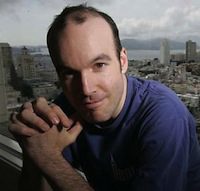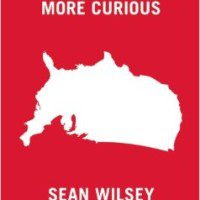To gauge by the 15 essays that comprise More Curious, Sean Wilsey’s curiosity runs rampant. (His paying job as a freelancing journalist, it would appear, serves his natural proclivities well.) As most essayists tend to be, he’s an avid student of the complexities of human nature. He’s observational but not didactic or doggedly argumentative. He’s evidently a bibliophile too, but one who’s happily and insistently catholic in his tastes: a comic book’s word bubble might intrigue him as much as a philosophic tome. And while his essays typically stem from personal experiences (a road trip, a bout as a volunteer, an interview assignment, another road trip), they branch out; they’re restless, rich with footnotes (in spirit if not in fact), asides, and digressions. Take this latter point as a compliment, though for a reader for whom, say, David Foster Wallace’s manic, scattered, and occasionally schizoid style is just too much, and for whom elegant symmetry and clearly announced key points are any essay’s marks of excellence, Wilsey might not be an optimal choice.
Consider “Using So Little” (2003). Characteristic of Wilsey’s approach, the essay contains reminiscences about his San Francisco boyhood, an actual recipe for Venom Surprise—“1 medium sized King Cobra (Rattlers will do. Sidewinders, Diamond Backs, take your pick),” etc.—several old letters to Thrasher magazine (complete with snide, single-line replies from its editor), a cellertracker.com [sic] review of a 1975 Cabernet Sauvignon, column excerpts from The Chef—Thrasher’s admired “wily, dirty, broke but unbroken” food columnist—and extensive quotations from skateboarding’s elder statesmen. Between all these bits Wilsey builds an essay that celebrates the essential if contradictory purity of skateboarding as a sport and a state of mind (“In a paved landscape skateboarders are both dangerous and invisible, inhabitants of the interstices—rats, the city a series of tunnels and chutes, skaters perfectly adapted”) while mourning its loss and railing against the corporate, celebrity-fixated ethos that has apparently taken hold (“And it’s hard not to hate how skating has changed”).
Whereas Wilsey identifies with rats there, his next essay, “Some of Them Can Read” (2005) (they’re printed chronologically in More Curious, 1998-2014, and first appeared in GQ, Gourmet, Vanity Fair, McSweeney’s Quarterly, London Review of Books, and New York Times Magazine), outlines a newly sprung mindset upon becoming a dad while dwelling on New York City’s colossal brown rat population—which are famously rumored to have eaten infants asleep in their cribs. Characteristically, Wilsey’s essay begins with quotations from “the mother of all New York rat pieces” (by Joseph Mitchell, first printed in 1944) and continues to alarm, educate, and entertain with correspondence from the city’s Department of Health and Mental Hygiene.

“The World I Want to Live In” (2006) tracks the roving nature of Wilsey’s soccer fandom, which he labels zealotry. The essay ably captures the author’s intense hero-worship (as a fan he’s a serial monogamist, magnetized by Cameroon’s wily and stylish Roger Milla, then the brilliant imbecility of England’s David Beckham, and so on) before offering a spirited account of watching, after that year’s World Cup had ended, 25 VHS cassettes of the 1970 World Cup. Entwined in these autobiographical snippets is a tentative argument about soccer’s quasi-spiritual capabilities: “What is soccer if not everything that religion should be? Universal yet particular, the source of an infinitely renewable supply of hope, occasionally miraculous, and government by simple, uncontradictory rules (‘Laws,’ officially) that everyone can follow”; “It’s a rare sport (let alone religion) that allows for both knowledge and wonder.” Wilsey opens a way for considering soccer as better than religion (since it can, in theory, unite the world) while admitting that such a fervent belief is, of course, also blinded by its own fervency.
A thematic companion piece that’s woven with fascinating anecdotes, “some obscure, suppressed, declassified, wonderful, and curious facts,” and interview subjects, “NASA Redux” (2009) affirms the cultural worth of the endangered organization’s “Star Trek-like” idealism. Signing off with a trip aboard the G-Force One and the delightful experience of (hungover) weightlessness, the essay asserts the value of wonder in general (and its effect on the suddenly floating passengers: “I could move in any direction. All was calm and effortless. And to an astonishing degree—astonishing largely because the understanding was so matter-of-fact, as though I’d begun to internalize my own understated Neil Armstrong—this sort of comfort with wonder felt like the goal of both science and religion.”)
Amusing and out-of-left-field, “The Objects of My Obsession” (2013) is founded on Wilsey’s “quasi-erotic attraction to well-built and beautiful objects,” in particular faucets, refrigerators, and stoves. Rather than getting introspective, though, he moves outward, describing his adventures (and misadventures) in buying these discounted, well-built and beautiful objects from Craigslist (a financial necessity after he buys a two-family dwelling in Brooklyn, and an ethical one because he’s outraged at the exorbitant retail prices of German fixtures and Italian ventilation hoods: “My conclusion: it’s a moral failing to buy retail, and it’s spiritually debasing to live with crap.”)
As evidenced by journeys to purchase kitchen equipment in New Jersey and to conduct interviews at Cape Canaveral’s Kennedy Space Center, Wilsey’s curiosity often takes him far from home. The fifty enchanting and intermittently surreal pages of “Travels with Death” (2008) document his impressions through the “comedy and poverty of the United States” as he and an acquaintance drive in a sluggish 1960 pickup truck from Texas to New York (with detours, naturally, and plentiful interactions with the oddball and ornery). A curious little outpost and artist colony in Far West Texas (founded by Donald Judd and lately in the news for the Prada Marfa art installation controversy) nearly possesses Wilsey. He devotes some seventy bookending pages to it in “The Republic of Marfa” (1998) and “Marfa, Revisited” (2000-2014). The essays about Wilsey’s former residence form a kind of striding, site-specific miscellany that covers (to barely scratch the surfaces of its topics) Russian literature, drug traffickers, David Foster Wallace, local eccentrics, history, regional traits, contemporary art and architecture, illegal weapons, unexplained natural phenomena, and Linneaus (the dog) and her litter of puppies. Unique in composition and decidedly strange, Marfa seems a natural fit, a trove in fact, for the author’s fascinated character. And the essays are a testament to Wilsey’s infectious ability to make his curiosity ours: Marfa’s a state of mind, a queerly-wrought community, and a fat slice of Americana, and we really want to go check it out now.




